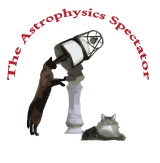
The basic layout of the site is as survey paths, which can be found under the Surveys link at the top of this and most other pages on this site. Each survey begins with a basic overview of the subject. Part of this overview include simulators of astrophysical phenomena that allow the reader to experiment with the phenomena. The later pages in a survey present the subject in greater and more mathematical depth. A path ends with research pages that describe current research projects and results in astrophysics.
The links at the top of each page are Home, which is the current home page of this site, Commentary, which is an index of short essays on topics loosely related to astrophysics, Surveys, which is the index of survey paths, Research, which is the index of research pages and the page leading to recent news items, Background, which is the index page for all background information on astrophysics, including survey pages, simulator pages, tables, bibliographic references, and lists of web resources, Previously, which is an index of previous home pages, and Site Info, which describes the site and its author, and gives contact information.
On the home page is found an addition link. This is the Store link, which leads to reviews of worthwhile books on astronomy and other relates subjects. Links on these pages enable the reader to buy these books from Amazon.com, which helps to financially sustain this web site.
Each Wednesday, a new issue of The Astrophysics Spectator is published that comprises a new home page, a new commentary, whatever news the author notices, and background, research, and simulator pages added to the survey paths. The home page acts as an index to the newly added pages. This site also has an RSS channel, whose link is given at the bottom of the right-hand column of this page.
May 25, 2005
This week I add several pages on accretion disks to the “Astrophysical Disks” survey path. In compact binary stars, where a degenerate dwarf star, neutron star, or black-hole candidate pulls gas from an orbiting companion star, the accretion disk carries the gas from the companion onto the surface of the compact object. The accretion disks in these systems are among the brightest objects in the sky, particularly in ultraviolet and x-ray energies. Accretion disks also are responsible for much of the light produced by the massive black hole candidates found at the centers of many galaxies. But accretion disks are not only found around exotic objects, they are also found around new stars. The planets of our solar system were formed from the remnants of the Sun's accretion disk.
Accretion disks behave as suggested by their name; they accrete gas onto the objects they rotate around. Turbulence in the disk provides viscosity that causes the disk to convert gravitational potential energy into light. While the physics of accretion disks is generally complex, because the processes associated with turbulence are themselves complex, some basic understanding of accretion disks is possible from simple Newtonian physics.
The first page added to the path gives a basic description of accretion disks. The remaining-two pages discuss a particular type of accretion disk: the Keplerian accretion disk. Keplerian disks are very common, and their behavior is relatively simple. The second new page discusses the structure of Keplerian accretion disks, and the third new page discusses the temperature and luminosity of these disks. These pages involve some simple mathematics. Don't worry, Microsoft's poor support of Internet standards in its browser is saving you from a mathematical onslaught.
I have modified the Special Relativity Simulator to match the definition of calculated distance used in the simulator to the definition given in its web page.
Jim Brainerd
Background
Introduction to Accretion Disks. Any massive object can capture gas in its gravitational field. Inevitably, the gas that is captured has some angular momentum, which sends it into an orbit around the capturing object. If enough gas is captured, it collapses into a disk. If viscosity in the disk is sufficiently high, the gas in the disk will be transported to lower orbits, until the gas finally drops onto the central source. This disk is an accretion disk, and it is found in many systems, because the gravitational potential energy liberated as the gas drops to lower orbits causes these disks to be bright. (continue)
Structure of Keplerian Accretion Disks. A Keplerian accretion disk has too little mass to produce a significant gravitational field. The gas in these disks therefore orbits the central object in Keplerian orbits. This page develops the structure of an accretion disk perpendicular to the plane of rotation. Generally, the thickness of an accretion disk is much less than its radius. This page describes both how gas pressure and radiative pressure determine the structure of an accretion disk. (continue)
Energetics of Keplerian Accretion Disks. The potential energy released as gas flows through an accretion disk is liberated as light. This page derives the minimum temperature of the accretion disk from the assumption that the disk radiates its energy as black-body radiation. This analysis gives a relationship between the temperature of the disk at a given radius and the accretion luminosity of the disk. (continue)
Update
Constant Acceleration Simulator. The constant-acceleration simulator shows how objects in free-fall appear to move for an observer accelerating at a constant rate. I have modified the simulator so that the apparent distance to an object is defined by its projected width on the sky. The web-page for the simulator gave a confused definition of the apparent distance, and the simulator gave the apparent distance as the path-length of the light traveling from the object to the observer. (continue)

RSS Channel
